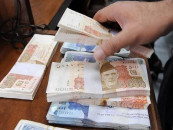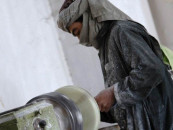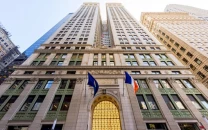Interest rate increased to 7.25% after a 15-month gap
MPC notes monetary policy stance is still appropriately supportive of growth

In a surprise move, Pakistan's central bank has increased the benchmark interest rate by 25 basis points to a 15-month high of 7.25% on Monday, reasoning that the “pace of economic recovery has exceeded expectations".
"(Economic) growth in FY22 is now expected towards the upper end of the forecast range of 4-5%, notwithstanding some greater uncertainty with respect to spillovers from the evolving situation in Afghanistan," the State Bank of Pakistan (SBP) said in its latest bi-monthly monetary policy statement (MPS).
The monetary policy committee (MPC) noted that the stance of monetary policy is still appropriately supportive of growth, “with real interest rates remaining negative on a forward-looking basis”.
The MPC expects monetary policy to remain accommodative in the near term, with possible further gradual tapering of stimulus to achieve mildly positive real interest rates over time. "The pace of this possible further gradual tapering would be informed by updated information on the continued strength of demand growth and the stance of fiscal policy, amongst other factors."
Pakistan’s economy heavily relies on imported goods to meet local demand on across the board including raw material for industrial and agricultural outputs, energy (oil and gas), foods (cooking oil, wheat and sugar) and plant and machinery for industrialisation.
READ FBR warns OMCs of fine, imprisonment
Accordingly, strong growth in import of goods and their skyrocketing prices at world markets are feared to accelerate inflation reading and widen current account deficit beyond affordable levels and set targets for FY22.
Secondly, the increase in the rate is made ahead of Pakistan’s scheduled formal meeting with the International Monetary Fund (IMF) at the end of the ongoing month of September to find a middle ground over the stringent condition from the latter to resume the $6 billion loan programme by the former, it was learnt.
Earlier, the SBP had held the rate 7% for the past 15 months to support the businesses and economy to recover from Covid-19 impact.
Prior to this, it aggressively cut the benchmark interest rate by 625 basis points during March-June 2020 to 7% to support businesses and households coping with the pandemic outbreak in the country since February 2020.
The interest rate and flexible rupee-dollar exchange rate mechanism remain two major tools available with the central bank to control inflation and give a direction to the domestic economy.
"While year-on-year inflation has declined since June, rising demand pressures together with higher imported inflation could begin to manifest in inflation readings later in the fiscal year," the SBP said.
"The economic recovery now appears less vulnerable to pandemic-related uncertainty. As a result, at this more mature stage of recovery, a greater emphasis is needed on ensuring the appropriate policy mix to protect the longevity of growth, keep inflation expectations anchored, and slow the growth in the current account deficit."
As foreshadowed in previous monetary policy statements, the MPC noted that this rebalancing would be best achieved by gradually tapering the significant monetary stimulus provided over the last 18 months.
READ New ordinance for non-filers, under-filers: Shaukat Tarin
"The MPC noted that over the last few months the burden of adjusting to the rising current account deficit had fallen primarily on the (rupee-dollar) exchange rate and it was appropriate for other adjustment tools, including interest rates, to also play their due role," the central bank said.
Inflation fell from 9.7% (year-on-year) in June to 8.4% in both July and August. Nevertheless, the momentum of prices remains relatively elevated, with month-on-month increases of 1.3% in July and 0.6% in August. In addition, inflation expectations of both households and businesses have drifted up and wage growth has picked up as recovery has strengthened.
"Looking ahead, the inflation outlook largely depends on the path of domestic demand and administered prices, notably fuel and electricity, as well as global commodity prices."
The current account deficit rose to $0.8 billion in July and $1.5 billion in August, reflecting both vigorous domestic demand and high global commodity prices. While remittances remained strong, growing by 10.4% (year-on-year) during July-August and exports also performing reasonably well (averaging $2.3 billion per month), they were outstripped by imports. In response, the rupee depreciated by 4.1% since the last MPC meeting.
With the flexible rupee-dollar exchange rate mechanism in place, SBP’s gross foreign exchange reserves have nearly tripled to a record $20 billion, while net international reserves have risen by nearly $16 billion between end-June 2019 and end-August 2021.
Most high-frequency domestic demand indicators such as automobiles, POL (petroleum, oil and lubricants) sales, cement sales and electricity generation continued to depict robust growth. This growth is mirrored in the strength of imports and tax collections. Large-scale manufacturing (LSM) registered strong growth in June (18.5% year-on-year) before moderating in August to 2.2%, in line with typical seasonal patterns.
The services sector is also rebounding strongly; latest Google Community Mobility Reports show that activity across grocery stores, restaurants, and shopping centres during July and August rose above pre-Covid levels. "In agriculture, the decline in the area under cultivation of cotton is expected to be compensated by an increase in area for rice, maize, and sugarcane," the SBP said.



















COMMENTS
Comments are moderated and generally will be posted if they are on-topic and not abusive.
For more information, please see our Comments FAQ